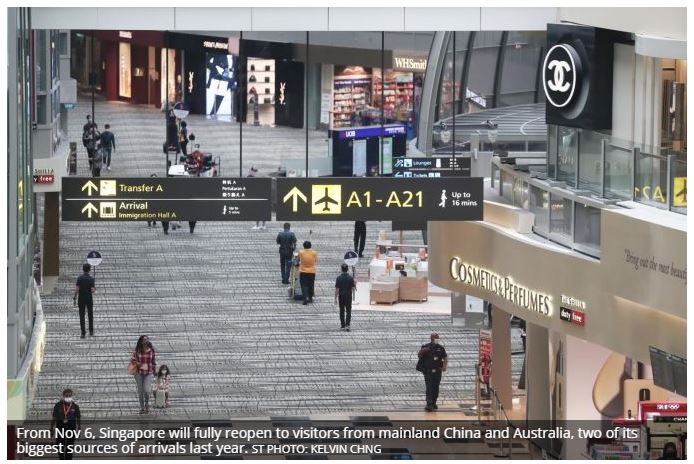Singapore reopens to China and Australia visitors from Nov 6
FROM Nov 6, Singapore will fully reopen to visitors from mainland China and Australia, two of its biggest sources of arrivals last year.
While the move is cheered by tourism and hospitality players, it may not immediately revive local tourism, with tour operators citing the need for reciprocity and more details on testing regimes.
The Civil Aviation Authority of Singapore (CAAS) said on Thursday that visitors travelling from mainland China and the state of Victoria in Australia can start applying from Oct 30 noon (Singapore time) for an Air Travel Pass for entry into the city-state on or after Nov 6.
Before this, Singapore had unilaterally opened its borders to travellers from Australia but excluded Victoria state, the epicentre of the country’s coronavirus outbreak.
Applicants must have remained in mainland China or Australia in the last 14 consecutive days prior to their entry. They will also need to undergo a polymerase chain reaction (PCR) test upon arrival at the airport in Singapore. If the result is negative, they will be allowed to go about their activities in Singapore without serving a Stay-Home Notice (SHN).
Visitors from these two countries made up about a quarter of total tourist arrivals to Singapore last year.
Mainland China was the top source tourist market for Singapore last year, accounting for 3.6 million visitors – about a fifth of all visitors – and S$4.1 billion in receipts excluding sightseeing, entertainment and gaming.
About 1.1 million tourists from Australia spent about S$1.3 billion here over the same period.
Singapore will also allow residents in the city-state to travel to Australia and China, but CAAS advised travellers to check the entry requirements imposed by these countries.
Singapore citizens, permanent residents and long-term pass holders returning from mainland China and Victoria state (Australia) from Nov 6 onwards will similarly undergo a PCR test upon arrival, If the result is negative, they will be allowed to go about their activities without serving SHN.
But Chan Brothers Travel noted that the Australian government has not lifted border restrictions on its end. With China, the current arrangement is that of a “fast lane” allowing for official or business travel to between Singapore and six provinces and municipalities in China.
“Ultimately with any kind of border lifting, especially in terms of leisure travel, it has to be reciprocal between both countries. This is also in terms of the requirements on travellers. Otherwise it will be quite difficult to roll out,” the travel agency said.
It added that it is most optimistic about the recently announced Singapore-Hong Kong “air travel bubble”.
Kwee Wei-Lin, president of the Singapore Hotel Association (SHA) said: “Almost 90 per cent of Singapore’s hotel revenue comes from international tourism. In contrast to the days when Singapore’s border was firmly closed to any form of foreign travel, this move is greatly appreciated by SHA.”
To facilitate travel plans, the organisation representing 160 member hotels has created a one-stop reference on its website for visitors.
Ms Kwee added that Singapore, being the first Asian country to reopen its borders to international travellers, is sending a strong and impactful signal that it is ready to safeguard public health as well as the safety of visitors.
CAAS said in its announcement that both mainland China and Victoria have “comprehensive public health surveillance systems” and “displayed successful control” over the spread of Covid-19.
It noted that over the past 28 days, mainland China and Victoria state have had virus local incidence rates of 0.00009 and 0.099 per 100,000 respectively. “The risk of importation from these places is low,” said the authority.
Alicia Seah, director of public relations and communications at Dynasty Travel, said: “(The border lifting) is definitely a good sign but we need more clarity about how travel is going to be carried out in a safe manner before we can understand the potential impact on travel agents.”
She noted that travellers would need to take the PCR test upon arrival in Singapore, but questioned if they would need to do so when departing from their home country. She also asked if they would need to be tested again upon returning to their home country.
“Travellers are eager to travel with testing regimes in place so that they can be free from fear and anxiety,” Ms Seah added, “but costs can also be a concern.”
A pre-departure PCR test in Singapore costs about S$200 while the one at Changi Airport sets the traveller back by S$300.
CAAS’ latest move follows the earlier lifting of border restrictions for visitors from Australia (excluding Victoria state), Brunei, New Zealand and Vietnam.
As at Oct 29 noon, Singapore has approved 1,375 applications from these places, and received 602 visitors. None of the visitors tested positive for the novel coronavirus.
Source: https://www.businesstimes.com.sg/government-economy/singapore-reopens-to-china-and-australia-visitors-from-nov-6


 Thailand
Thailand




